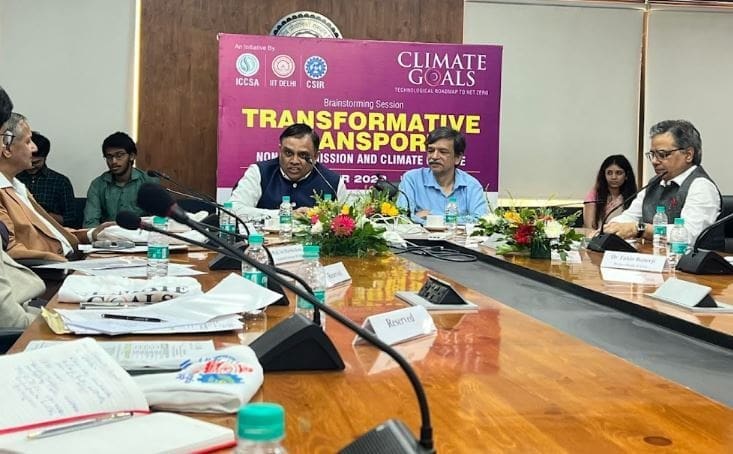Even as CNG is gaining popularity and becoming the most preferred automobile fuels in India, primarily because of its low cost, and high calorific value, it is a concern due to its contribution to global warming and atmospheric pollution. Experts, therefore, have suggested faster adoption of zero-emissions technology to mitigate transport methane emissions.
Dr J S Sharma Head ICCSA, Prof. T.G Sitharam Chairman, AICTE, Prof. Rangan Banerjee, Director IIT Delhi, Dr Rakesh Kumar Officer on Special Duty CSIR
Currently, Indias CNG penetration in the transport sector is about 10 percent to 12 percent. It should start shifting more towards 20-25 percent by 2030, CNG passenger vehicle sales in the just-ended FY2023 increased by 40.71% compared to FY2022, accounting for 8.80% of the overall retail sales of 36,20,039 PVs.
“While CNG usage surge is expected to continue to grow in the transport sector, there are some challenges to be overcome, including leakage of methane. It contains 80 to 90 percent methane. Methane emissions from CNG-operated vehicles have become a growing concern due to their contribution to atmospheric pollution. CNG vehicles emit a significant amount of CH4 as a slip and CO and HCHO gases due to partial oxidation,” Dr J S Sharma Head of International Center for Climate and Sustainability Action Foundation (ICCSA) said.
Prof. T.G Sitharam Chairman of AICTE, said, “Developing Indias transportation sector is the backbone of its economic development, contributing significantly to GDP growth but emissions from the Transport sector are unavoidable and pose a significant challenge to Indias sustainability goals at the workshop Transformative Transport Non-CO Emissions and Climate Change,” jointly organised by ICCSA, IIT Delhi and Council for Scientific and Industrial Research.
Prof. Sitharam said that AICTE will look to inculcate greater training amongst the students on various environmental issues and said that greater emphasis should be given to hands-on learning and internships in this domain.
Dr Rakesh Kumar Officer on Special Duty at Council for Scientific and Industrial Research (CSIR) said, “Research and development for sustainable transportation alternatives, such as multi-modal transport and hydrogen-powered vehicles, can reduce methane emissions from the global transportation sector.”
The surge in CNG vehicle sales in India reflects a growing preference for cleaner and more sustainable transportation options despite higher methane emissions. This trend reflects a shift towards reducing carbon footprints and promoting environmental conservation in the automotive industry.
Prof. B. Sengupta, former member secretary, CPCB said, “Fugitive methane emissions from CNG vehicles and stations are a major environmental concern due to methanes impact, and strict technological measures can reduce it.”
Prof. Sengupta emphasized the need for regular audits of CNG stations to identify and address fugitive emissions. He also said that conventional kitchen burners previously used for LPG when used for PNG led to 25% CH4 leakage into atmosphere. Governments should educate the public regarding the need to change of these old burners.
Dr RR Sonde, Professor of the Department of Chemical Engineering IITD said that Zero Leakage design and monitoring system are necessary to control transport emissions and ensure environmental sustainability. These systems play a crucial role in reducing the release of harmful pollutants into the atmosphere. Implementing zero leakage design and monitoring systems can also contribute to meeting regulatory standards and improving overall air quality.
Reduction of Methane emissions is the most cost-effective method to fight global warming by switching the global transport sector to zero emissions technologies. This has the potential to reduce the impact of climate change. Developing these technologies can also help to reduce air pollution in cities. Moreover, they could create many job opportunities in the renewable energy sector.
AvinashKumarAgarwal,Professor,Dept of Mechanical Engineering,IITKanpur said that well maintained CNG cars were much better from an environmental footprint point as compared to EVs and tailpipe emissions from the properly maintained cars were overall much cleaner than the ambient air. But this statement was with riders as the poorly maintained CNG cars were an entirely different story and can be much more detrimental to the environment due to leakages.
Prof. Rangan Banerjee, Director of IIT Delhi, Shri Rajesh Gupta, Director at NITI Aayog, Mr. Alok Kumar, GM (T) of NHAI, representatives of various pollution control boards and other experts from the scientific institutes such as NEERI, CRRI, NPL, NITs were part of the brainstorming session on transformative transport non-CO2 emissions and climate change at IIT Delhi.
To mitigate methane emissions, the automobile industry must develop advanced zero-leakage designs and monitoring systems, which are critical to fuel efficiency, vehicle safety, and environmental protection, said Dr J S Sharma.
It’s crucial to ensure that CNG vehicles meet strict emission standards, Moreover, it is important to ensure that CNG stations are properly regulated and maintained to reduce fugitive emissions. This becomes more important when we realize that more than 5500 CNG filling stations are there in the country with more than 500 existing in NCR alone.
A pledge was made during a brainstorming session on transport emissions to formulate policy and a roadmap for methane mitigation using available technologies and also developing new technologies to capture fugitive methane. India is already in the process of transitioning to renewable energy sources, investing heavily in renewable energy to reduce its carbon intensity.

